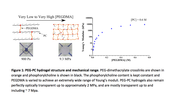Highlight
PEG-PC is a novel hydrogel suitable for cell culture and has one of the widest mechanical ranges reported for a hydrogel to date
Achievement/Results
William Herrick (ICE IGERT trainee) and Dr. Shelly Peyton (ICE IGERT Advisor) of the University of Massachusetts Amherst Chemical Engineering Department, along with their collaborators Dr. Todd Emrick and Samantha MacRae of the Polymer Science & Engineering Department, have developed and characterized a novel hydrogel for use as a cell culture platform to study how cells sense and respond to the mechanical forces in the surrounding microenvironment. For many years, basic biology and medical research with cells has been performed on glass or plastic surfaces, which do not resemble human tissue. In recent years, the burgeoning field of mechanobiology has revealed that the softness (or stiffness) of the underlying surface impacts cell behavior in development and disease. This field benefits from the invention and characterization of tunable materials, especially hydrogels, that are inexpensive, easy to make, and capable of matching the stiffness of any tissue of interest.
To address this need, Herrick and Peyton have developed PEG-phosphorylcholine (PEG-PC), a hydrogel with remarkable mechanical properties. PEG-PC in particular has an extremely wide range of possible stiffnesses: it can be made as soft as ~ 1 kPa and as stiff as ~ 10 MPa by varying the concentration of crosslinker (Figure 1). The novel component of the hydrogel, phosphorylcholine, is a zwitterion comonomer that is naturally found in cell lipid bilayers, and therefore has excellent biocompatibility without interfering with cell adhesion to the biomaterial. The phosphorylcholine comonomer imparts not only excellent mechanical properties but also optical transparency. Furthermore, PEG-PC hydrogels can be made quickly, inexpensively, and easily with free radical-initiated polymerization. In comparison, there are hyaluronic acid-based hydrogels with a similar mechanical range, but they are more expensive, difficult to make, and have undesirable biological effects. This work was accepted for publication in the journal Biomacromolecules in June 2013 (DOI: 10.1021/bm400418g). The Peyton Group is now using the PEG-PC system extensively to study various areas of mechanobiology and disease, especially cancer metastasis and atherosclerosis. The properties of PEG-PC are so favorable compared to commonly used PEG and polyacrylamide hydrogels that we expect PEG-PC could very well become a standard hydrogel platform for performing simple mechanobiology and any other experiment where substrate modulus is a desired parameter.
Address Goals
Our achievement primarily addresses a research infrastructure goal. This hydrogel has the potential to become a widely used standard hydrogel platform to study disease pathology and basic cellular biology in academia and industry. Owing to its remarkable properties and ease of use, this achievement indirectly addresses a discovery goal by providing an extremely useful platform to perform discovery research to address issues in health and basic science.






